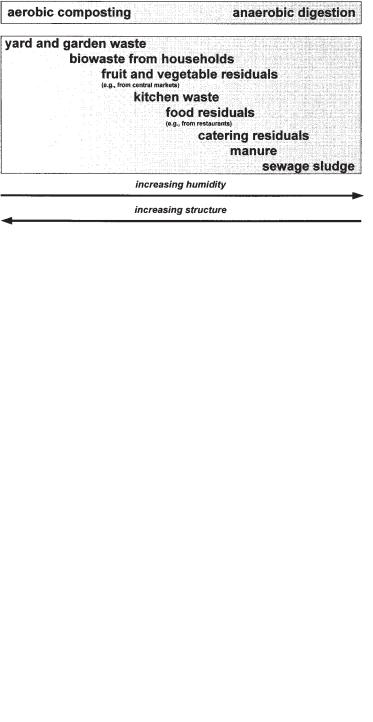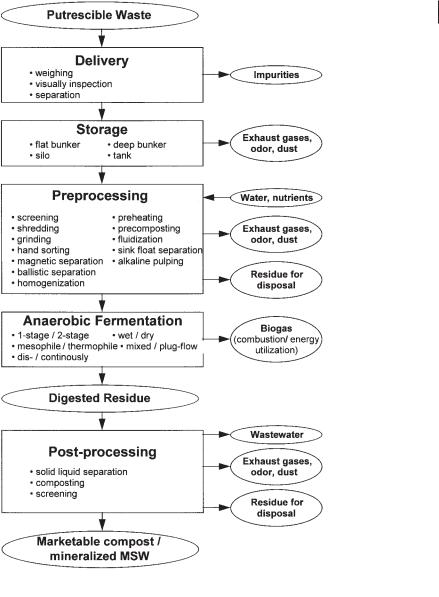
Environmental Biotechnology - Jordening and Winter
.pdf
356 14 Anaerobic Fermentation of Wet and Semidry Garbage Waste Fractions
tific expenditure, process developments and optimizations are being pursued, so it may be assumed that the technological potential of biowaste fermentation has not yet been fully exhausted.
14.2.1
Biochemical Fundamentals of Anaerobic Fermentation
Biogas is produced whenever organic matter is microbially degraded in the absence of oxygen. In nature this process can be observed in marshlands, in marine sediments, in flooded rice fields, in the rumen of ruminants, and in landfill sites (Maurer and Winkler, 1982).
Anaerobic degradation is effected by various specialized groups of bacteria in several successive steps, each step depending on the preceding one. For industrial-scale application of anaerobic fermentation processes it is necessary to have a thorough knowledge of these interactions, to avoid substrate limitation and product inhibition.
The entire anaerobic fermentation process can be divided into three steps (Fig. 14.1):
1.hydrolysis
2.acidification
3.methane formation
At least three groups of bacteria are involved in the anaerobic fermentation process. First, during hydrolysis, the mostly water-insoluble biopolymers such as carbohydrates, proteins, and fats are decomposed by extracellular enzymes to water-soluble monomers (e.g., monosaccharides, amino acids, glycerin, fatty acids) and thus made
accessible to further degradation.
In the second step (acidification) the intermediates of hydrolysis are converted into acetic acid (CH3COOH), hydrogen (H2), carbon dioxide (CO2), organic acids,
Fig. 14.1 The three stages of anaerobic processing of organic matter (Sahm, 1981).

14.2 Basic Aspects of Biological Waste Treatment 357
amino acids, and alcohols by different groups of bacteria. Some of these intermediate products (acetic acid, hydrogen, and carbon dioxide) can be directly used by methanogenic bacteria, but most of the organic acids and alcohol are decomposed into acetic acid, hydrogen, and carbon dioxide during acidogenesis. Only these products, as well as methanol, methylamine, and formate, can be transformed into carbon dioxide and methane (CH4) by methanogenic bacteria during the third and last step, methane formation.
14.2.1.1Hydrolytic and Acid-forming (Fermentative) Bacteria
The first group of bacteria is very heterogeneous: besides obligate anaerobic bacteria, also facultative anaerobic bacterial strains occur. The high molecular weight compounds of the waste biomass (proteins, polysaccharides, fats) are decomposed into low molecular weight components by enzymes that are excreted by fermentative bacteria. This first step is inhibited by lignocellulose-containing materials, which are degraded only very slowly or incompletely. Subsequently, acid-forming bacteria transform the hydrolysis products into hydrogen, carbon dioxide, alcohols, and organic acids such as acetic, propionic, butyric, lactic, and valeric acids. The formation of the acids decreases the pH.
14.2.1.2Acetic Acidand Hydrogen-forming (Acetogenic) Bacteria
The group of acetogenic microorganisms represents the link between fermentative and methanogenic bacteria. They decompose alcohols and long-chain fatty acids into acetic acid, hydrogen, and carbon dioxide. It is a characteristic of acetogenic bacteria that they can grow only at a very low hydrogen partial pressure. For this reason they live in close symbiosis with methanogenic and sulfidogenic bacteria, which use hydrogen as an energy source (Sahm, 1981).
14.2.1.3Methane-forming (Methanogenic) Bacteria
The group of methanogenic bacteria is formed of extreme obligate anaerobic microorganisms which are very sensitive to environmental changes. They transform the final products of acidic and acetogenic fermentation into methane and carbon dioxide. About 70% of the methane is produced by the degradation of acetic acid and about 30% by a redox reaction from hydrogen and carbon dioxide (Roediger et al., 1990).
The slowest step is rate-determining for the whole process of anaerobic fermentation. Although methanogenesis of acetic acids is the rate-limiting step in the anaerobic fermentation of easily degradable substances, hydrolysis can be rate-limiting when sparingly degradable substances occur. Because of the complexity of the anaerobic degradation mechanisms and the stringent requirements of the microorganisms, process operation is very important for fermentation processes. To achieve optimized, undisturbed anaerobic degradation, the speed of decomposition in the consecutive steps should be equal.

35814 Anaerobic Fermentation of Wet and Semidry Garbage Waste Fractions
14.2.2
Influence of Processing Conditions on Fermentation
The activity of microorganisms in anaerobic fermentation processes depends mainly on water content, temperature, pH, redox potential, and the presence of inhibitory factors.
14.2.2.1 Water Content
Bacteria take up the available substrates in dissolved form. Therefore, biogas production and the water content of the initial material are interdependent. When the water content is below 20% by weight, hardly any biogas is produced. With increasing water content biogas production is enhanced, reaching its optimum at 91%–98% water by weight (Kaltwasser, 1980).
14.2.2.2 Temperature
The process of biomethanation is very sensitive to changes in temperature, and the degree of sensitivity depends on the temperature range. For most methane bacteria, the optimum temperature range is between 30 and 37 °C (Maurer and Winkler, 1982). Here, temperature variations of ±3 °C have minor effect on the fermentation (Winter, 1985). In the thermophilic range, however, i.e., at temperatures between 55 and 65 °C, a fairly constant temperature has to be maintained, since deviations by only a few degrees cause a drastic reduction of the degradation rates and thus of biogas production.
14.2.2.3 pH Level
The pH optimum for methane fermentation is between pH 6.7 and 7.4. If the pH of the medium drops below 6, because the balance is disturbed and the acid-producing dominate the acid-consuming bacteria, the medium becomes inhibitory or toxic to the methanogenic bacteria. In addition, strong ammonia production during the degradation of proteins may inhibit methane formation if the pH exceeds 8. Normally, acid and ammonia production vary only slightly due to the buffering effect of carbon dioxide/bicarbonate (CO2/HCO3 – ) and ammonia/ammonium (NH3/NH4+), which are formed during fermentation, and the pH normally stays constant between 7 and 8.
14.2.2.4 Redox Potential and Oxygen
Methane bacteria are very sensitive to oxygen and have lower activity in the presence of oxygen. The anaerobic process, however, shows a certain tolerance to small quantities of oxygen. Even continuous, but limited, oxygen introduction is normally tolerated (Mudrak and Kunst, 1991). The redox potential can be used as an indicator of the process of methane fermentation. Methanogenic bacterial growth requires a relatively low redox potential. Hungate (1966; cited by Braun, 1982) found –300 mV to

14.2 Basic Aspects of Biological Waste Treatment 359
be the minimum value. Changes in redox potential during the fermentation process are caused by a decrease in oxygen content as well as by the formation of metabolites like formate or acetate.
14.2.2.5Inhibitory Factors
The presence of heavy metals, antibiotics, and detergents can inhibit the process of biomethanation. With reference to investigations of Konzeli-Katsiri and Kartsonas (1986), Table 14.1 lists the limit concentrations (mg L–1) for inhibition and toxicity of heavy metals in anaerobic digestion.
14.2.3
Gas Quantity and Composition
Biogas is a mixture of various gases. Independent of the fermentation temperature, a biogas is produced which consists of 60%–70% methane and 30%–40% carbon dioxide. Trace components of ammonia (NH3) and hydrogen sulfide (H2S) can be detected. The caloric value of the biogas is about 5.5–6.0 kWh m–3. This corresponds to about 0.5 L of diesel oil.
If the chemical composition of the substrate is known, the yield and composition of the biogas can be estimated from Eq. (1) (with reference to Symons and Buswell, 1933):
CnHaOb + n – |
a |
– |
b |
H2O → |
n |
+ |
a |
– |
b |
CH4 + |
n |
– |
a |
+ |
b |
CO2 |
(1) |
|
|
|
|
|
|
|
|
||||||||||
4 |
2 |
2 |
8 |
4 |
2 |
8 |
4 |
Table 14.2 shows the mean composition and specific quantity of biogas as dependent on the kind of degraded substances.
For anaerobic digestion of the organic fraction of municipal solid waste, an average biogas yield of 100 m3 t–1 moist biowaste and having a methane content of about 60% by volume may be assumed.
Table 14.1 Inhibition of anaerobic digestion by heavy metals (Konzell-Katsiri and Kartsonas, 1986).
Heavy Metal |
Inhibition |
Toxicity |
|
(mg L–1) |
(mg L–1) |
|
|
|
Copper (Cu) |
40–250 |
170–300 |
Cadmium (Cd) |
– |
20–600 |
Zinc (Zn) |
150–400 |
250–600 |
Nickel (Ni) |
10–300 |
30–1000 |
Lead (Pb) |
300–340 |
340 |
Chromium III (Cr) |
120–300 |
200–500 |
Chromium VI(Cr) |
100–110 |
200–420 |
|
|
|

36014 Anaerobic Fermentation of Wet and Semidry Garbage Waste Fractions
Table 14.2 Mean composition and specific yields of biogas in relation to the kind of substances degraded.
|
|
CH4 |
CO2 |
Substance |
Gas Yield |
Methane Content |
Carbon Dioxide Content |
|
(m3 kg–1 TS) |
(Vol. %) |
(Vol. %) |
|
|
|
|
Carbohydrates |
0.79 |
50 |
50 |
Fats |
1.27 |
68 |
32 |
Proteins |
0.70 |
71 |
29 |
Municipal solid waste (MSW) |
0.1–0.2 |
55–65 |
35–45 |
Biowaste |
0.2–0.3 |
55–65 |
35–45 |
Sewage sludge |
0.2–0.4 |
60–70 |
30–40 |
Manure |
0.1–0.3 |
60–65 |
35–40 |
|
|
|
|
14.2.4
Comparison of Aerobic and Anaerobic Waste Treatment
Professional biological treatment must include the separation of interfering matter, sanitation, and microbial degradation of the readily and moderately degradable substances so that the final product is biologically stable, compatible with plant roots, and, as far as possible, free of pollutants and can be applied as a soil improver in horticulture and agriculture. Aerobic composting and anaerobic fermentation are, in principle, available as processes for the biological treatment of organic residues.
Composting is suitable for the stabilization of rather dry solid waste, and anaerobic processes are used for very moist waste (e.g., kitchen garbage) which is easy to degrade. Both systems have advantages and disadvantages. Their general properties are listed and compared in Table 14.3.
A great advantage of anaerobic fermentation is the production of biogas that can be used as a source of energy. Either local users can be found for the gas recovered from the process, or it can be cleaned and upgraded for inclusion in a gas supply network. By way of comparison, during composting all the energy is released as heat and cannot be used. In addition, intensive composting requires a lot of energy for artificial aeration of the waste material.
The technical expenditures for anaerobic fermentation are higher than for composting, but if standards, especially concerning the reduction of emissions (odor, germs, noise, dust), are raised, the technical expenditures for composting can be expected to grow as well.
The duration of anaerobic and aerobic treatment depends very much on the substrate and the process used, so that the times required cannot be compared in general. The same is true for the floor space required.
A major advantage of anaerobic digestion in comparison with aerobic composting is the ability of engineers to have total control over gaseous and liquid emissions, as well as having the potential to recover and use methane gas generated as the wastes degrade. For composting, the problem of odor control has not yet been sufficiently

14.3 Processes of Anaerobic Waste Treatment 361
Table 14.3 Comparison of aerobic and anaerobic waste treatment (according to Rilling, 1994a).
Characteristics |
Anaerobic Digestion |
Aerobic Composting |
|
|
|
Phases |
solids, liquid |
solids, liquid, gas |
Degradation rate |
up to 80% volatile solids |
up to 50% volatile solids |
Energy consumption |
excess produced |
demands input |
Technical expenditure |
in the same range |
|
Duration of the process |
1–4 weeks |
4–16 weeks |
|
(only anaerobic stage) |
(depending on the process) |
Post-treatment |
generally necessary |
generally none |
|
(post-composting about 2–8 weeks) |
|
Floor space required |
comparatively low |
comparatively low or high |
|
|
(depending on the process) |
Odor emission |
comparatively low |
comparatively high |
Stage of development |
little experience but increasing |
much experience |
Costs |
in the same range |
|
Sanitation |
external process step |
integrated |
Suitability of wastes |
wide (wet and dry wastes) |
narrow (dry wastes) |
|
|
|
solved. Large volumes of odiferous waste air have to be treated by costly means to avoid complaints from surround communities. In contrast, hardly any odorous emissions occur in anaerobic fermentation, because this biological treatment takes place in closed reactors. Malodorous waste air is produced only during loading and unloading the reactor.
No general statement can be made as to whether anaerobic or aerobic fermentation is the more favorable process, as in each individual case many factors must be considered. This means that in the field of waste treatment, as well as in the field of wastewater treatment, several different processes with similar goals can have certain advantages – depending on the operational area.
14.3
Processes of Anaerobic Waste Treatment
Anaerobic fermentation has been used successfully for many years as a treatment for wastewater, sewage sludge, and manure. However, anaerobic digestion of municipal solid waste is a relatively new technique which has been developed in the past 10–15 years.
Only biodegradable household wastes – i.e., those of organic or vegetable origin – can be processed in anaerobic digestion plants. Garden waste, or green wastes as they are often called, can also be included, but woodier materials (like branches) are less suitable because of their relatively longer decomposition time under anaerobic conditions.

362 14 Anaerobic Fermentation of Wet and Semidry Garbage Waste Fractions
As a result of anaerobic fermentation combined with an additional post-compost- ing step, a material is produced that is usually similar to the compost produced by aerobic processes. It can be used as fertilizer, soil conditioner, or peat substitute.
Although composting is widely used for wastes containing high amounts of dry matter, anaerobic digestion has turned out to be a good alternative for treating wet organic wastes (Fig. 14.2). At present, the anaerobic fermentation technique is mainly used in Western Europe, where more than 30 companies offer anaerobic treatment plants commercially for the digestion of putrefiable solid waste.
14.3.1
Procedures of Anaerobic Waste Fermentation
Generally, the following steps are required for the anaerobic treatment of organic waste (Rilling, 1994a):
1.delivery and storage of the biological waste
2.preprocessing of the incoming biological waste
3.anaerobic fermentation
4.storage and treatment of the digester gas
5.treatment of the process water
6.post-processing of the digested material
Figure 14.3 shows the possible treatment steps used in biowaste fermentation. In principle, all fermentation processes can be described as a combination of a selection of these treatment steps. The process technology demanded for the implementation of the different steps of the treatment differs very much, depending on the anaerobic process chosen. In general, the gas production increases and the detention time decreases with increasing energy input for preparation of the material and the fermentation itself (mesophilic/thermophilic).
Fig. 14.2 Suitability of wastes for aerobic composting and anaerobic digestion (according to Kern et al., 1996).

14.3 Processes of Anaerobic Waste Treatment 363
Fig. 14.3 Possible treatment steps used in biowaste fermentation.
14.3.1.1Delivery and Storage
For both composting and fermentation the wastes are pretreated before the actual biological stabilization occurs. The supplied biowastes are quantitatively and qualitatively recorded by weighing, are visually inspected at an acceptance station, and are unloaded into a flat or deep bunker or a collecting tank that serves as a short-term intermediate storage place and permits continuous feeding to the subsequent pretreatment plant.

364 14 Anaerobic Fermentation of Wet and Semidry Garbage Waste Fractions
14.3.1.2 Preprocessing
The purpose of pretreatment is to remove pollutants and interfering matter as well as to homogenize and condition the biowaste. The kind of pretreatment depends on the specific system of the anaerobic fermentation process.
Dry fermentation processes use dry preprocessing, where sieves, shredders, grinders, homogenization drums, metal separators, ballistic separators, and hand sorting sections can be combined. In wet fermentation processes the biowastes are additionally mixed with water, homogenized, and shredded. By means of sink–float separation other foreign substances can be removed.
14.3.1.3 Anaerobic Fermentation
Having separated any recyclable or unwanted materials from the incoming wastes, the organic material is shredded and fed into the digester. Shredding results in a material that can be handled more easily. In addition, material having a larger surface area is more easily broken down by the bacteria. Shredding in a drum can be combined with a precomposting step. However, shredding causes the material to lose structure. The desired particle size after shredding may be between 5 and 40 mm, in certain cases up to 80 mm. Yard and garden waste (especially branches, etc.) have to be shredded separately before composting.
If very wet wastes, like sewage sludge, are included, the addition of further water may not be necessary, but for household organic wastes, water is usually added to dilute the solids.
Wastes with low structure and a high moisture content are best for fermentation, but wastes rich in structure can also be degraded anaerobically by means of dry fermentation processes. Heat is needed to adjust the required process temperatures to about 35 °C (mesophilic process) or 55 °C (thermophilic process), and sometimes water must be added. During fermentation, organic degradation takes place anaerobically, i.e., under the exclusion of oxygen, in closed, temperature-regulated containers. Depending on the process operation, the material consistency may vary between well-structured matter and thick sludge or fluid suspension. The optimum pH value is in the neutral range.
The output of the fermentation reactor is a wet, organically stabilized, fermentation residue and biogas. After dewatering, a soil-improving product comparable to compost can be obtained from the fermentation residue by aerobic post-compost- ing. The wastewater generated during draining can in part be recirculated into the pretreatment unit to adjust the water content. Surplus wastewater has to be treated and discharged. With only minor energy loss, the biogas can be used in decentralized fuel-burning power stations to produce electrical power and heat so that, in general, the fermentation process can be operated in an energy-neutral manner, and the surplus can be marketed by feeding it into the public power and heat supply mains.
When the fermentation is confined only to easily degradable organic waste components, energy can be produced with minimal technical expenditure, and the odor and energy-intensive prefermentation steps can be omitted. In a subsequent composting step the medium and difficult-to-degrade organic substances, which can be

14.3 Processes of Anaerobic Waste Treatment 365
degraded anaerobically only to a limited extent, are aerobically decomposed at low cost. Thus, when investigating the question of ‘fermentation or composting’ the answer may often suggest the demand for fermentation and composting.
14.3.1.4Post-processing
To complete the stabilization and disinfection of the digested residue, some kind of refining process is needed before it can be used for agriculture or horticulture. After possible dewatering and/or drying, the anaerobically fermented waste is generally transferred to aerobic biological post-treatment and matured for about 2–4 weeks to become a good, marketable compost.
After drying and, if required, purification, the biogas can be used as an energy source.
Depending on local regulations, the excess process water is transferred to a wastewater treatment plant or may be applied directly to farmland as a liquid fertilizer.
14.3.2
Process Engineering of Anaerobic Fermentation of Biowastes
Anaerobic fermentation processes are generally suitable for the biological treatment of readily degradable substances having low structure and high water content, e.g., kitchen waste. At present, several processes for the anaerobic fermentation of organic solid wastes are under development. The processes differ in the number of biodegradation stages (oneor two-stage processes), separation of liquid and solids (oneor two-phase system), water content (dry or wet fermentation), feed method (continuous or discontinuous), and the means of agitation. The most important characteristics of anaerobic fermentations are compiled in Table 14.4.
Anaerobic fermentation of biowaste can be achieved by one-stage or two-stage fermentation. In the one-stage process (Table 14.5) hydrolysis, acidification, and methane formation take place in one reactor, so it is not possible to achieve optimum re-
Table 14.4 Characteristics of anaerobic waste treatments (according to Rilling, 1994a).
Characteristics
Stages of biodegradation |
one-stage |
two-stage |
Separation of liquid and solids |
one-phase |
two-phase |
|
dry fermentation |
wet fermentation |
Total solids content |
25%–45% |
<15% |
Water content |
55%–75% |
>85% |
Feed method |
discontinuous |
continuous |
Agitation |
none |
stirring, mixing, percolation |
Temperature |
mesophilic (30–37 °C) |
thermophilic (55–65 °C) |
|
|
|
